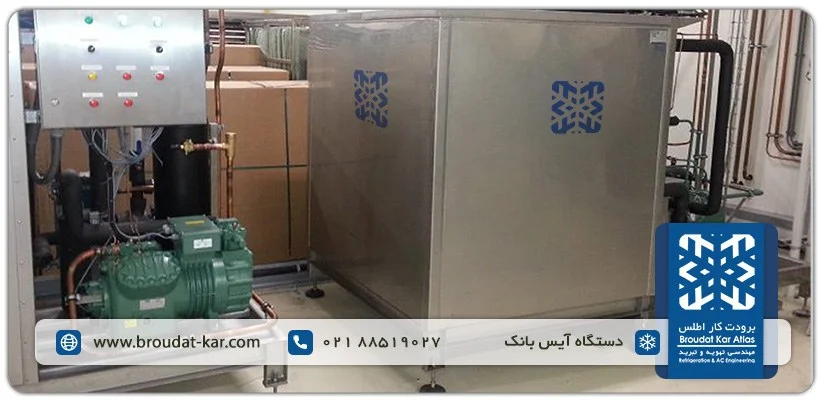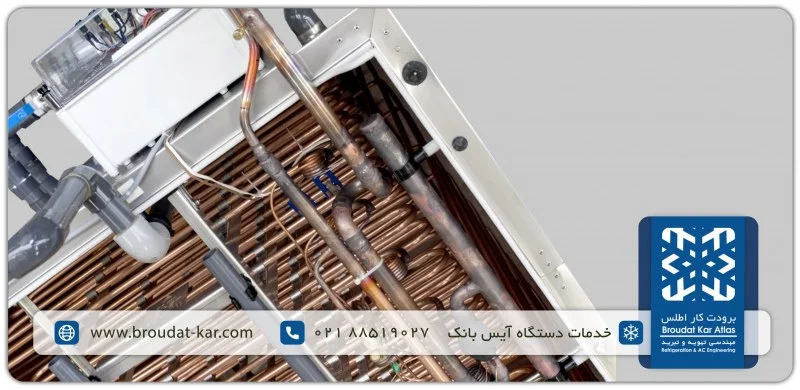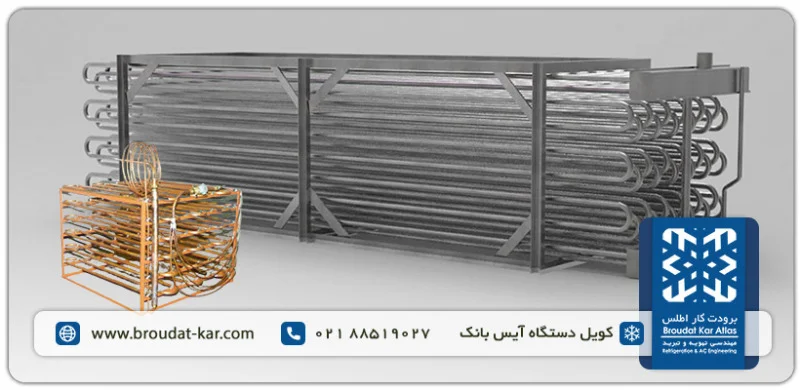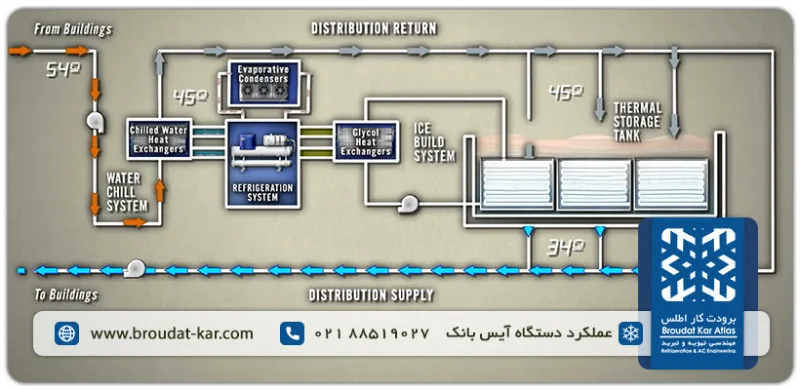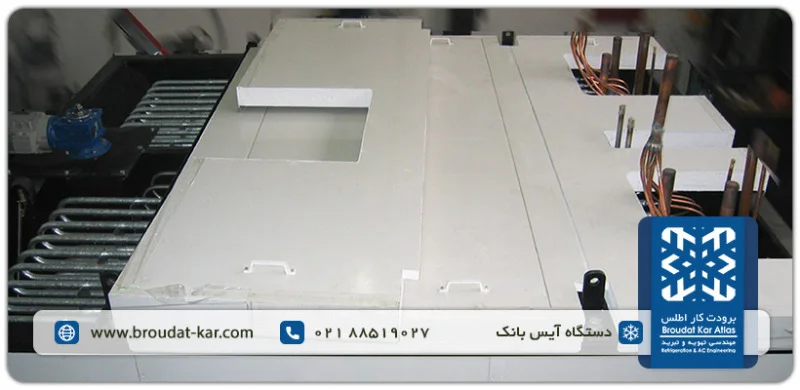What is an Ice Bank?
An Ice Bank, as its name implies, functions as an equipment to generate, store, and utilize ice for cooling, refrigeration, or air conditioning purposes. It serves as a practical refrigeration system employed across various industries for diverse applications. Additionally recognized as an energy storage system, the Ice Bank employs a traditional method to optimize energy usage and curtail electricity consumption. It finds extensive use, particularly in the food and dairy sectors.
In the latter part of the 20th century, the necessity arose to diminish energy usage, particularly during peak periods, notably hot days when a substantial portion of energy consumption was attributed to ventilation and refrigeration systems. Research conducted in the United States indicated that during summer, more than one-third of the total electricity consumed was allotted to refrigeration systems. Thus, storing cooling energy during off-peak hours emerged as a viable strategy for significantly reducing energy consumption during peak periods. This concept gained prominence among consumers with the implementation of tariffs, escalating electricity prices during peak times, and incentives encouraging consumers to shift their high-energy consumption to non-peak hours. By storing energy in ice form during off-peak periods, significant reductions in electricity costs were achievable, along with the potential for smaller-sized refrigeration equipment, leading to reduced initial costs.
Ice bank technology is utilized as an efficient solution in food, pharmaceutical, air conditioning industries, and more. This technology, which was developed in the early 20th century, serves as a significant method for storing and utilizing energy in the form of ice. Ice banks are also recognized as one of the methods for energy storage during off-peak hours.
Introduction to the Atlas Refrigeration Ice Bank
An Ice Bank, also referred to as an ice reservoir, serves as an system designed to generate and store ice during periods of low energy demand, strategically utilizing it during peak hours. Its application extends to scenarios where refrigeration load needs fluctuate. Take, for instance, the dairy industry, where a substantial volume of milk needs rapid chilling. A dairy farm ice bank, stocked overnight with a significant ice supply, converts it into cold water, circulating this through milk coolers to efficiently chill the milk. Utilizing lower nighttime temperatures optimizes refrigeration system performance, thereby reducing power needs and initial investment costs. In many cases, the savings accrued from downsizing the refrigeration setup are adequate to cover the Ice Bank’s construction costs, often negating the need to factor in reduced electricity bills.
Ice Banks stand out as remarkably practical refrigeration systems utilized across diverse industries. A prevalent challenge in industrial cooling systems involves the high-power consumption of compressors and motors. The adoption of Ice Banks is steadily gaining traction owing to their role in curbing energy expenses and reducing upfront investments. Businesses, ranging from large-scale industrial enterprises to residential and office air conditioning setups, are increasingly embracing this technology.
Ice Bank Design
Designing an Ice Bank entails careful consideration of various parameters. The experts at Atlas Refrigeration meticulously scrutinize the following key factors in Ice Bank design:
- Determining the cooling load profile.
- Selection of Ice Bank reservoir types.
- Specifications of the refrigeration equipment utilized.
- Development of operational and control strategies.
- Understanding the interaction between equipment and consumers.
- Estimating the necessary size of the Ice Bank system.
- Conducting an economic feasibility study.
- Evaluating performance and maintenance requirements.
- Overseeing commissioning and execution processes.
Atlas Refrigeration specializes in tailoring Ice Banks to suit the unique needs of each project. The design and construction of these systems involve precise calculations and considerations tailored to individual Ice Bank requirements. For personalized consultation regarding your Ice Bank project design, feel free to reach out to us.
Technical Specifications of Ice Banks
The Ice Banks crafted by this company exhibit a versatile capacity range, spanning from 3 to 5000 tons of refrigeration, tailored to meet the specific demands of individual projects. These Ice Banks employ a variety of refrigerants, including ammonia, ethylene glycol, and propylene glycol. The construction materials utilized encompass steel, stainless steel, copper, and aluminum. Furthermore, the Ice Banks manufactured by this company feature high-quality valves, pumps, and control equipment.
Highlighted below are some notable attributes of the Ice Banks produced by this company:
- Provision of water at approximately zero degrees Celsius or an ethylene glycol solution in glycol Ice Banks at around -13 degrees Celsius.
- Maintenance of stable water temperatures.
- Efficient energy transfer facilitated by turbulence generation within the reservoir.
- Enhanced safety owing to the less of rotating or moving components within the setup.
- Minimal installation space requirements.
- Reduced refrigerant quantity within the system.
- Extended operational lifespan achieved through the use of stainless steel and PVC components in contact with water.
- Compatibility with a wide array of refrigerants, including ammonia.
Ice Banks possess adaptable characteristics that vary depending on their specific application, thus lacking a fixed set of technical specifications. For comprehensive details regarding the technical specifications of Ice Banks, we encourage you to get in touch with us.
Ice Bank Equipment
The Ice Bank system comprises a collection of devices and equipment, encompassing the following key components:
- Ice Bank coil, also referred to as the evaporator, crafted from materials such as galvanized coil, copper coil, or pillow plates
- Compressor and condenser assembly or chiller
- Water circulation pump and associated valves
- Control valves and controllers
- Insulated water reservoir
- Electrical panel
- Agitator or mixer
It’s apparent that achieving a high-efficiency and long-lasting Ice Bank system necessitates the utilization of top-quality equipment tailored for operational conditions. All equipment and devices employed by this company in constructing Ice Banks adhere strictly to global refrigeration standards.
Operation of Ice Bank
Ice Banks encompass a range of devices that facilitate ice production on the surface of the evaporator coil or plates submerged within an insulated water reservoir. The ice formed on this heat exchanger surface—be it in tube or plate form—is not utilized as ice; rather, it serves to reduce the temperature of the surrounding circulating water. Following the nightly cycle and ice storage in the Ice Bank reservoir, the accumulated cold is then utilized during periods of peak consumption.
The water requiring temperature reduction circulates within the Ice Bank reservoir, coming into direct contact with the ice formation or within the tubes/plates, absorbing heat and consequently lowering its temperature. Subsequently, through a defined process, once the water temperature is raised again, it is pumped back into the Ice Bank to facilitate the melting of more ice and prepare for subsequent use.
In an Ice Bank system, the addition of an ethylene glycol solution to the water reservoir enables a reduction in the freezing point of solution to approximately -13 degrees Celsius. This adjustment allows for lower temperatures and, consequently, enhances operational efficiency.
Ice bank capitalizes on the latent heat of fusion of ice to convert water into ice during off-peak electricity periods. Essentially acting like a battery, it stores thermal energy in the form of ice around coils or on the surfaces of dual-layer alloy plates, to be used during peak cooling demand periods, where circulating warm water around the ice initiates a highly efficient cooling process.
Types of Ice Banks
Ice Banks are categorized into four types based on their operational modes, as detailed below:
Full reservoir operation
In this mode, the entire required cooling capacity is shifted to non-peak hours. The refrigeration system or chiller operates at maximum capacity during off-peak periods, storing the generated cooling in the Ice Bank for later use during peak consumption. As a result, refrigeration devices avoid operating during the hottest hours, characterized by high condenser temperatures. This approach significantly reduces electricity consumption and wear on the devices.
Partial reservoir Operation and Load Leveling
This mode involves the Ice Bank supplying a portion of the required cooling load, while the remainder is provided by the refrigeration system. Load leveling entails continuous operation of the refrigeration system round the clock. During periods when the cooling load is less than the chiller’s capacity, the surplus is stored in the Ice Bank. Subsequently, during peak load periods, the stored cooling is utilized from the Ice Bank.
Partial reservoir Operation and Demand Limiting
Similar to the previous mode, this approach utilizes a section of the reservoir to be supplied by the Ice Bank, with the rest provided by the refrigeration system. However, to curtail energy consumption during peak periods, the chiller operates at a capacity lower than its maximum. It functions at maximum capacity only during off-peak hours, storing the excess capacity produced in the Ice Bank.
Sequencing of Chillers
In this method, separate refrigeration systems are employed to charge the Ice Bank and provide cooling to other consumers. At least two chiller units are utilized: one to charge the Ice Bank and the other to directly supply the system. The direct servicing of the load occurs as long as the cooling load remains within the chiller’s capacity. However, when the load exceeds its capacity, the Ice Bank is utilized for additional support.Top of Form
Advantages of Using Ice Banks
As previously mentioned, Ice Banks serve diverse purposes. For instance, their use in dairy industries, when compared to a AC chiller Ice Bank, exhibits distinct performance characteristics. Below, we’ll delve into a comprehensive examination of the advantages associated with Ice Bank utilization.
Reduction in Initial Capital Investment
Incorporating an Ice Bank into the refrigeration cycle leads to a diminished requirement for compressor and condenser capacity. Typically, refrigeration equipment is designed to meet cooling demands during peak consumption periods. However, with the utilization of an Ice Bank, these devices’ capacity can be reduced by up to 60%. This reduction stems from the refrigeration system operating continuously, storing cooling as ice for later use during peak consumption periods.
Consequently, surplus cooling required during peak periods is supplied from the stored ice in the Ice Bank during nighttime, eliminating the necessity for a condenser and compressor with 100% cooling capacity. Moreover, in Ice Bank systems, the supplied chilled water temperature is at zero degrees Celsius (a mixture of water and ice in the Ice Bank reservoir), approximately 7 degrees lower than that supplied by a chiller. This reduction in water temperature also reduces the required volume of chilled water for cooling, subsequently diminishing water pump, pipe sizing, and electrical panel requirements.
Reduction in Energy Consumption Costs
Ice Bank systems produce and store cooling continuously throughout the day, eliminating the need for high electricity consumption during peak hours. Substantial cooling is stored in the Ice Bank during off-peak periods, resulting in significantly lower electricity consumption during peak times. Additionally, Ice Bank systems exhibit lower power consumption in refrigeration equipment, further reducing electricity usage.
In HVAC systems where Ice Banks are employed, this technology can address a key factor contributing to increased construction costs—high electricity demand. Studies indicate HVAC systems in a building can consume up to 40% of its electricity. Ice Banks effectively mitigate these electricity demand costs.
Increase in System Reliability
Conventional refrigeration systems employ two compressors, each at 50% cooling capacity, to achieve 100% peak cooling capacity. This setup enables the system to operate at 50% capacity, with one compressor serving as backup in case of failure. In contrast, Ice Bank systems, utilizing two compressors at 30% of peak cooling capacity and 40% cooling from the Ice Bank, ensure coverage of 70% peak cooling capacity in case of a compressor malfunction.
Reduced Service and Maintenance
Ice Bank systems typically require less service and maintenance due to their minimal moving parts, resulting in lower periodic service needs compared to compressors.
Environmentally Friendly Solution
Nighttime electricity production is about 30% less polluting due to higher power plant efficiency during this period. Therefore, the utilization of Ice Bank systems, enabling nighttime electricity consumption, significantly contributes to reducing environmental pollution.
Ice Bank Applications
Ice Banks play a crucial role in reducing electricity consumption during peak working hours by storing energy as ice overnight. With water latent heat of fusion of 80 kcal per kilogram, ice serves as an exceptional medium for energy storage. Ice Bank system designs typically cater to projects falling within the following categories:
1- When the maximum cooling load significantly exceeds the average load.
– Example: HVAC systems in buildings requiring high cooling loads for limited daytime hours. Similarly, milk chillers may necessitate substantial cooling for a single shift in each dairy farm.
2- When peak consumption of the cooling load demands Ice Bank intervention.
– Designing the system to allow the Ice Bank to manage a portion of the cooling load proves cost-effective. This approach minimizes the necessity for lower-capacity refrigeration equipment, reducing costs and electricity consumption.
Ice Banks have diverse applications across various industries, including:
– Construction and Concrete industries
– Dairy industries
– Aquaculture and fishery industries
– Industrial bakeries
– Beverage production industries
– HVAC systems
– Semi-prepared food production industries
Moreover, it’s notable that larger capacities usually employ ammonia-based Ice Banks, whereas smaller Ice Banks utilize freon refrigerant as the coolant.Top of Form
Buying Guide for Various Types of Ice Banks
Atlas Refrigeration stands as a reliable provider of top-quality refrigeration and ice bank systems, backed by our cutting-edge technical expertise and skilled workforce. Prioritizing the complexity underlying the seemingly simple Ice Bank systems, we strongly advise consulting our experts before making a purchase decision.
For a tailored Ice Bank solution—determining the suitable type, capacity, refrigerant, and required equipment—we encourage engaging with our specialists. By articulating the specific needs and nuances of your project, our experts can offer the most optimal and cost-efficient solution tailored to your requirements. From the initial design phase to installation and ongoing after-sales services, our team remains dedicated to supporting you every step of the way.
Ice Bank Price List
Creating a comprehensive price list for various Ice Banks poses a challenge due to the pricing dependency on multiple factors. Estimating the price of an Ice Bank involves meticulous examination of the following aspects:
- System’s Cooling Capacity
- Intended Use of the Ice Bank
- Refrigerant Type (Ammonia-based or Freon-based)
- Estimated Water Tank Capacity of the Device
- Ice Bank Power Estimation Corresponding to the Chiller
- Specific Type and Brand of Equipment Utilized in Ice Bank Construction
- Material Composition of the Ice Bank Tank and Heat Exchanger
- Method Employed for Ice Storage within the Device
To obtain detailed information regarding Ice Bank pricing or to place an order for a customized Ice Bank tailored to your project’s needs, please don’t hesitate to reach out to us.
Services of Atlas Refrigeration (Design, Construction, Implementation, and Maintenance)
With a 40-year history in the refrigeration industry and a skilled and experienced workforce, Atlas Refrigeration can design, build, and implement Ice Bank systems for esteemed clients in the best possible way. The calculations for the Ice Bank system are performed by the experienced engineers of the company, ensuring the quality and accuracy of the produced Ice Bank. Installation, commissioning, and synchronization services of the Ice Bank with the refrigeration system or chiller are provided by our company.
All Ice Bank devices manufactured by this company come with a one-year warranty and 15 years of after-sales service. For Ice Bank price estimation and free consultation regarding the purchase and sale of small Ice Banks or industrial ammonia-based Ice Banks, contact our specialists.
Conclusion
This article begins by introducing the Ice Bank device and delves into its design parameters and general technical specifications. It then proceeds to outline the components of the Ice Bank, offering insights into the operational mechanisms of the system. Further, it explores strategies for effectively utilizing the Ice Bank and highlights the advantages associated with its use. Conclusively, the article explores the diverse applications of Ice Banks across various industries, accompanied by a comprehensive buying guide and calculations pertinent to Ice Banks.Top of Form
Related posts
Ice Bank
What is dairy cold storage? Dairy cold storage stands as a pivotal element within the dairy industry, crucial for the
What is Air Conditioning? Air conditioning encompasses the regulation of temperature, humidity, and air quality within indoor spaces, aiming to
